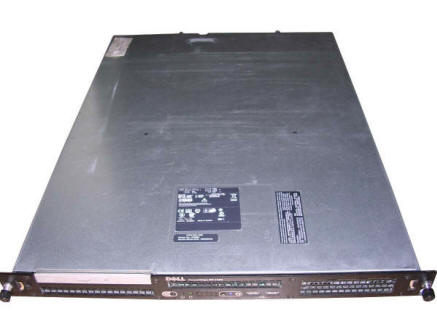Dell PowerEdge SC1425
This exhibit is too new for this collection. I decided
to put a limit on ca. 1GHz machines, which became widespread around
2002. However, I decided to put this machine in my webpage just to show how
it looks inside.
This is a typical Xeon-based Blade-type server, usually installed in a
rack. It has 2 dual-thread 3GHz Xeon CPUs and 8GB of RAM. It allows two
3.5" SATA disk drives to be installed. Display driver is not a bog thing
- ATI Mobility series, like one from the laptop, but these servers were
rarely connected to display - most maintenance has been made using
serial port.
The place of this machine is a rack in server room, so its 11 fans (8
for CPUs, 2 for power supply unit, 1 for hard disk) make quite
significant noise. It can be expanded with PCI-X board.
The operating system installed on it is currently Debian Linux. It
doesn't need any drivers and just works.
| Manufacturer | Dell | |
| Origin | USA | |
| Year of unit | 2007 | |
| Year of introduction | 2006? | |
| Class | ATX | |
| CPU | 2x Intel Xeon | |
| Speed | 3GHz | |
| RAM | 8GB (4x2GB DDR DIMM) |
|
| ROM | PC BIOS | |
| Graphics | ATI Mobility? | |
| Sound | None | |
| System expansion bus | PCI-X 1 slot | |
| Floppy/removable media drives | None | |
| Hard disk: |
40GB and 80GB, SATA. IDE CD-ROM - notebook-like. |
|
|
Peripherals in collection: |
||
| Other boards:
|
None | |
| Non-standard expansions: | On-board 2 network adapters | |
| Operating system(s): | Debian GNU/Linux 8. |
This particular unit has been bought to replace older
Athlon-based server in company which made web services. It was working
for few years (being upgraded from 2GB to 8GB of RAM) and then was
withdrawn from inventory, one employee took it to try to adapt it as
home computer. After it became totally obsolete as a server, I got it
with some other pieces of unneeded hardware.
My unit has a flaw, a defect in graphics system as in text mode picture
is partially filled with garbage characters. These characters persist
even when text-mode is redirected to serial port (yes, garbage passes
through serial port), so it can be problem with e.g. BIOS.
| Contents: | Starting, usage | Linux through serial port | Links |
Starting
The machine boots typical Dell/Phoenix BIOS, but it can be configured to be used through serial port. Unfortunately any problem with text mode is visible on serial port too, probably BIOS takes information from graphics memory and passes it to serial port.
Later it loads all ROM expansions: Network-boot PXE ROM and RAID controller ROM.
Installation of Debian through serial port
To prepare Linux installation media to be installed through serial port, you can use this forum post (archived) but instead of remaking ISO from scratch, you can just use any ISO file manager to modify image, in my case, in Linux, I used ISOMaster.
Burn CD, boot the server off it, use 115200bps, 8-bit, no parity, 1 stop bit, VT100 emulation (nullmodem cable) and see how the Linux runs. For obvious reasons only a simplified text-mode installer is available.
Remember that this particular machine boots very slowly. It loads BIOS, all extensions, looking for network from BIOS, then it launches PXE looking for network again, and, RAID driver detecting disks. Diagnostic LEDs slowly change their states. Finally it boots from CD-ROM first, then tries HDD.
http://www.dell.com/support/home/us/en/19/product-support/product/poweredge-1425sc/manuals
- Support page. Download documentation for it.





